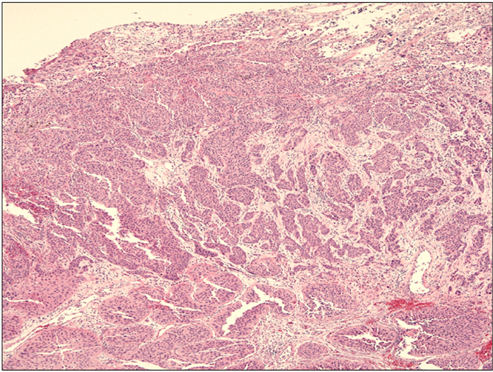Korean J Urol.
2012 Nov;53(11):807-809.
Urothelial Carcinoma Arising from a Large Ureteral Polyp
- Affiliations
-
- 1Department of Urology, Inje University College of Medicine, Busan, Korea. urokang@gmail.com
- 2Department of Pathology, Inje University College of Medicine, Busan, Korea.
Abstract
- We report an unusual case of a urothelial tumor on a ureteral polyp without hydronephrosis. The patient was a 50-year-old male. He had experienced several episodes of gross hematuria. Cystoscopy revealed a tumor that periodically prolapsed into the bladder. The tumor had a smooth-surfaced stalk with an erythematous, edematous lesion at the end. Tomography showed a mass and filling defect at the left ureterovesical junction. The results of urine cytology tests were negative. After the tumor was identified as a urothelial carcinoma by frozen biopsy analysis, a ureteroscopic resection was performed. The final pathological diagnosis was urothelial carcinoma arising in a ureteral polyp. No recurrence of the tumor or polyp was observed at the 3-month follow-up. To our knowledge, this is the first report in the Korean population of a urothelial tumor arising from a ureteral polyp.
Keyword
MeSH Terms
Figure
Reference
-
1. Johnin K, Kadowaki T, Kushima M, Ushida H, Koizumi S, Okada Y. Primary heterologous carcinosarcoma of the ureter with necrotic malignant polyps. Report of a case and review of the literature. Urol Int. 2003. 70:232–235.2. Zervas A, Rassidakis G, Nakopoulou L, Mitropoulos D, Dimopoulos C. Transitional cell carcinoma arising from a fibroepithelial ureteral polyp in a patient with duplicated upper urinary tract. J Urol. 1997. 157:2252–2253.3. Yoon CJ, Shin HS, Cho CK, Park TC. A case of congenital fibroepithelial polyp of the ureter in a child. Korean J Urol. 2001. 42:457–460.4. Ahn JW, Rho JH, Kim YS, Hong SJ, Lee MS. Case of giant ureteral polyp. Korean J Urol. 1994. 35:906–908.5. Lee WM, Paik SS, Hong EK, Park MH, Lee JD. Ureteral fibroepithelial polyp: a report of four cases (one case with nephrogenic adenoma). Korean J Pathol. 1996. 30:715–720.6. Lee SJ, Lim GH, Joung EH, Ko ST, Shin KY, Han YT. A case of fibroepithelial polyp of the ureter. Korean J Urol. 1991. 32:685–687.7. Kim SO, Youn CW, Kang TW, Im CM, Jung SI, Oh KJ, et al. Multiple, bilateral fibroepithelial polyps causing acute renal failure in a gastric cancer patient. J Korean Med Sci. 2010. 25:644–646.8. Davides KC, King LM. Fibrous polyps of the ureter. J Urol. 1976. 115:651–653.9. Kim KY, Lee TY. A case of primary upper ureteral polyp. Korean J Urol. 1995. 36:463–466.10. Kim H, Kim DK, Lee SJ, Chang SG. Fibroepithelial ureteral polyp: a case report; endoscopic removal of large ureteral polyp. J Korean Med Sci. 1996. 11:80–83.
- Full Text Links
- Actions
-
Cited
- CITED
-
- Close
- Share
- Similar articles
-
- Fibroepithelial ureteral polyp: a case report; endoscopic removal of large ureteral polyp
- A Case of Ureteral Intussusception with Giant Ureteral Polyp
- De Novo Papillary Urothelial Carcinoma at a Previous Ureteroneocystostomy Site for Benign Ureteral Injury
- Ureteral fibrous polyp: report of 2 cases
- Case of Giant Ureteral Polyp





